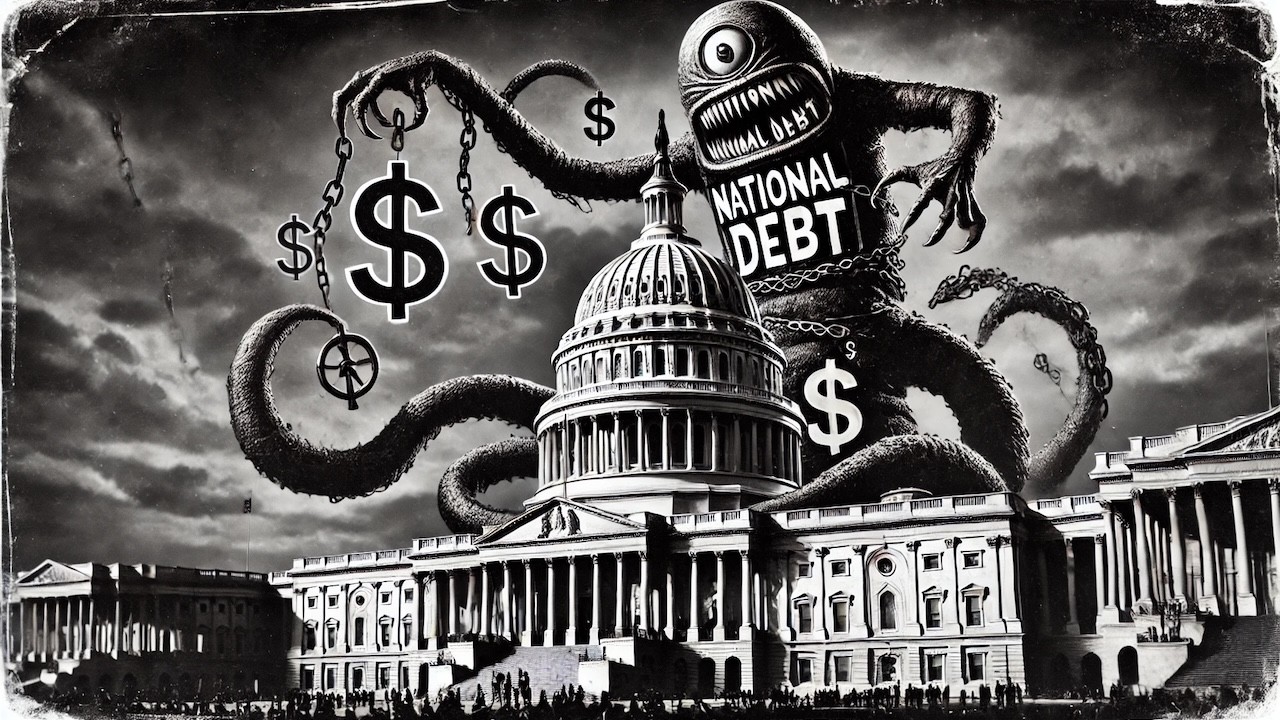(Mike Maharrey, Money Metals News Service) It took 118 days to add another trillion dollars to the national debt. That’s just under 16 weeks.
On Thursday, Nov. 21, the national debt officially blew past $36 trillion.
To be exact, it hit $36,034,994,586,981.97.
You might be thinking, “Didn’t we just eclipse $35 trillion?
Yes.
It was on July 26, just under four months ago.
The growth of the national debt is actually accelerating. It took almost six months to grow it from $34 trillion to $35 trillion.
Going back a little further, when Congress effectively eliminated the debt ceiling on June 5, 2023, the national debt stood at $31.46 trillion. Since then, the Biden administration has added $4.54 trillion to the national debt. That’s in just 18 months for those of you keeping track at home.
This isn’t shocking when you realize Uncle Sam is blowing through about half a trillion dollars every single month. The Biden administration just ran the third-largest budget deficit in history.
To be fair, this isn’t just a Biden problem. Every president since Calvin Coolidge has left the U.S. with a bigger national debt than when he took office.
Trump has at least talked about slashing the size of government, but he’s going to need to do better than he did during his first term.
The Trump administration almost hit the $1 trillion mark in 2019 and was on pace to run a trillion-dollar deficit in fiscal 2020 before the pandemic, even as the U.S. supposedly enjoyed the “best economy” ever. The economic catastrophe caused by the government’s response to COVID-19 gave policymakers an excuse to spend with no questions asked, and we saw record deficits in fiscal 2020 and 2021.
Even if the Trump administration manages to slash discretionary spending as promised, that only accounts for 27 percent of total spending. The vast majority is for entitlements, and there is little political will to take the scissors to Social Security or Medicare.
To put the debt into perspective, every American citizen would need to write a check for $106,647 to pay off the debt.
Of course, a lot of people don’t pay taxes. That means the taxpayer burden is much higher. Every U.S. taxpayer would have to write a check for $272,821 to wipe out the debt. And that’s on top of the taxes we already pay!
To put it another way, $36 trillion is more than the total economies of China, Japan, Germany, and the UK combined.
The debt to GDP ratio has climbed to 122.85 percent. Studies have shown a debt-to-GDP ratio of over 90 percent retards economic growth by about 30 percent.
You will find some more perspective on the enormity of the debt HERE.
What’s the Big Deal?
I consistently report on budget deficits and the growth of the national debt, but the truth is most people don’t really care.
In fact, a lot of people are under the illusion that the debt doesn’t matter.
James Madison disagreed. He called public debt “a public curse, and in a Rep. Govt. a greater than in any other.
Thomas Jefferson also disagreed. He called public debt “the greatest of dangers to be feared.”
So did George Washington.
“No pecuniary consideration is more urgent than the regular redemption and discharge of the public debt. On none can delay be more injurious or an economy of time more valuable.”
But why does it matter?
At some point, the world will decide it’s no longer interested in financing the U.S. government’s borrowing and spending.
Sure, there is a healthy demand for U.S. Treasuries — for now. But it isn’t infinite.
Ultimately, a lack of confidence in the U.S. fiscal situation could also lower demand for U.S. debt. There are already signs this is happening.
In fiscal 2024, the U.S. government spent over $1 trillion just making interest payments on the debt. It was the second biggest spending category in 2024, bigger than national defense and bigger than Medicare. The only spending category that was bigger was Social Security.
As demand for Treasuries drops, interest rates must rise even higher to attract investors, exacerbating the interest payment problem.
The hope is the Fed’s pivot to rate cuts will relieve some of the interest pressure, but so far, that hasn’t happened.
It’s quite possible that the Fed won’t be able to lower federal borrowing costs with even with deeper interest rate cuts.
Ultimately, the federal government needs the Fed to step in and put its big fat thumb on the bond market. That would mean a return to quantitative easing (QE).
In QE operations, the central bank buys Treasuries on the open market. This increased (artificial) demand drives bond prices higher and puts downward pressure on yields. This would be an ideal scenario for the U.S. government. It needs all the help it can get to facilitate its borrow/spend addiction.
But the Fed runs QE operations with money created out of thin air. The new money gets injected into the monetary system and the economy. This is, by definition, inflation.
As the Bipartisan Policy Center points out, the growing national debt and the mounting fiscal irresponsibility undermine the dollar.
“Confidence in U.S. creditworthiness may be undermined by a rapidly deteriorating fiscal situation, an increasing concern with federal debt set to grow substantially in the coming years.”
This could lead to lower economic growth, higher unemployment, and less investment wealth.
The bottom line is just because the debt hasn’t caused a crisis doesn’t mean it won’t. After all, things happen slowly and then all at once.
Mike Maharrey is a journalist and market analyst for MoneyMetals.com with over a decade of experience in precious metals. He holds a BS in accounting from the University of Kentucky and a BA in journalism from the University of South Florida.

